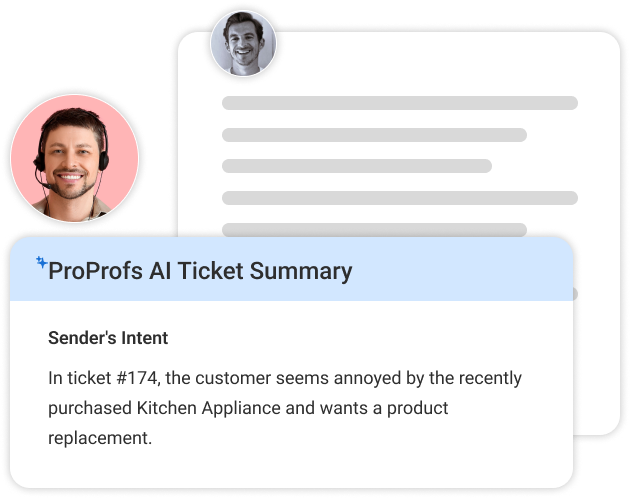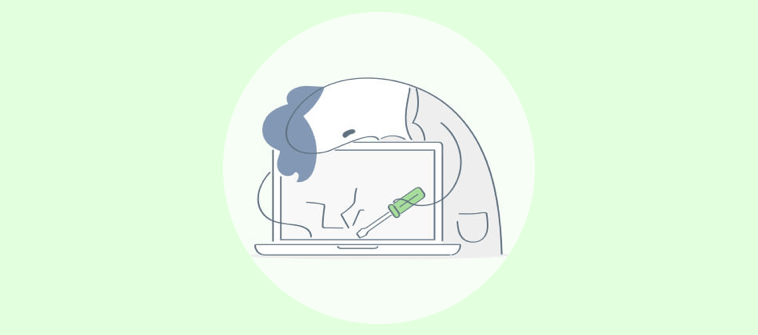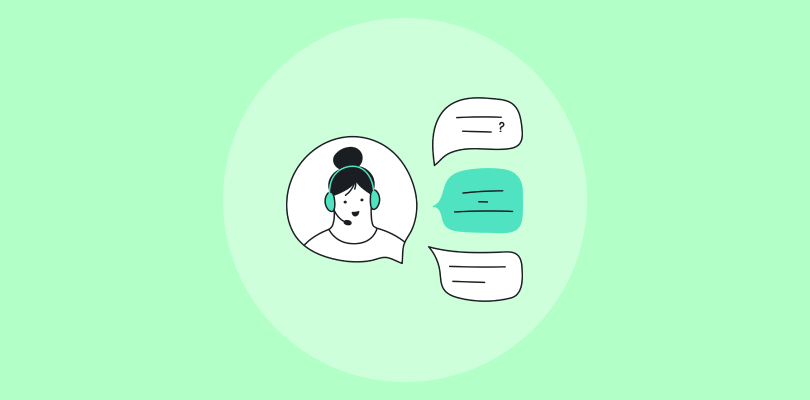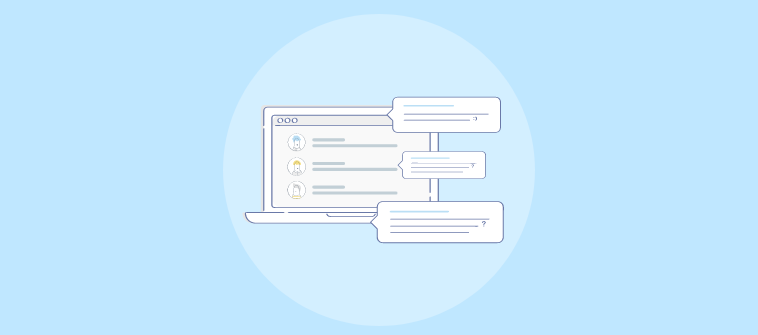Navigating the world of support can feel like deciphering a cryptic language, especially when terms like “help desk” and “service desk” get thrown around interchangeably.
While they both aim to assist users, they’re not quite the same.
So, in the battle of help desk vs. service desk, which one is meant for your team? Understanding the nuances between a help desk and a service desk is crucial for any organization looking to optimize its IT support and deliver a truly satisfying user experience.
In this blog, we’ll break down the key differences between a help desk and a service desk, helping you determine which one aligns best with your business needs. Let’s dive in!
What Is a Help Desk?
A help desk is a single point of contact for users needing assistance with a particular service or product. Its primary function is to help users resolve technical issues, answer questions, provide guidance, or restore functionality quickly and efficiently.
It is commonly staffed by support agents who manage support tickets, troubleshoot problems, and streamline communication between users and the IT or customer service team.
Help Desk Query Examples:
- “My email is not working. Can you help me reset my password?”
- “How do I install the latest software update?”
- “The website is loading slowly. Can you check for any server issues?”
- “I accidentally deleted an important file. Can it be recovered?”
What Is a Service Desk?
A service desk is a broader support function that includes help desk capabilities but also focuses on IT service management (ITSM) and business process improvement.
Service desk services aim to handle incident management, service requests, problem resolution, and change management to ensure smooth IT operations and user support.
Service Desk Query Examples:
- “Can you provide access to a new software application for my team?”
- “We need to set up a new workstation for a remote employee. What’s the process?”
- “A system outage is affecting multiple users. When will it be resolved?”
- “What’s the status of my request for increased storage capacity?”
Help Desk vs. Service Desk: Key Differences
While both help desks and service desks focus on improving support, they differ in scope, purpose, and approach. Here are four key differences:
1. Scope & Functionality
A help desk primarily focuses on resolving support issues and managing tickets. A service desk goes beyond troubleshooting and includes service requests, change management, and IT service delivery.
2. Proactive vs. Reactive Approach
A help desk is reactive, addressing user-reported problems and incidents as they arise. A service desk is proactive, aiming to prevent issues through IT service management (ITSM) strategies.
3. User Support vs. Business Alignment
A help desk provides support for end-users, helping them resolve their technical queries. A service desk aligns IT services with business goals, ensuring seamless service delivery.
4. Self-Service & Knowledge Base
A help desk may offer basic self-help options, such as FAQs and canned responses. A service desk includes a robust knowledge base, self-service portal, and automation to reduce support dependency.
Here is a small table to sum up the differences.
Help Desk vs. Service Desk: A Quick Comparison
| Feature | Help Desk | Service Desk |
|---|---|---|
| Primary Focus | Incident resolution & technical support | IT service delivery & support management |
| Approach | Reactive – fixes user-reported issues | Proactive – improves IT services & prevents issues |
| Scope | Limited to troubleshooting & ticket management | Covers ITSM, change management, & service requests |
| Self-Service | Basic FAQs & canned responses | Advanced knowledge base & self-service portal |
What Are the Benefits of a Help Desk?
A help desk is essential for providing quick and efficient support to users, managing tickets, and ensuring users get timely assistance. Here are some key benefits of using a help desk:
1. Faster Issue Resolution
Help desks streamline issue resolution by providing a structured ticketing system. Support agents can prioritize, track, and resolve problems efficiently, reducing downtime. This leads to quicker responses and improved user satisfaction.
2. Centralized Support Management
A help desk acts as a single point of contact for all user queries and IT-related issues. It consolidates support requests from multiple channels, ensuring better organization and visibility of ongoing issues.
3. Improved Productivity
By automating repetitive tasks and using canned responses, help desks help agents save time. Users also get access to self-service options like FAQs and knowledge bases, reducing dependency on live agents.
4. Enhanced User Experience
Help desk services provide timely assistance, ensuring users can continue their tasks without major disruptions. Personalized responses and proactive support further enhance the overall experience and satisfaction levels.
FREE. All Features. FOREVER!
Try our Forever FREE account with all premium features!
What Are the Benefits of a Service Desk?
A service desk helps organizations improve service delivery, automate workflows, and ensure smooth IT operations. Here are some key advantages of using a service desk:
1. Comprehensive IT Service Management (ITSM)
Service desks go beyond issue resolution and focus on delivering complete IT services. They support incident management, service requests, change management, and problem resolution, ensuring smooth IT operations.
2. Better Alignment with Business Goals
Service desk services align IT support with business objectives by providing structured workflows. This ensures that IT strategies contribute to overall business efficiency and long-term success.
3. Increased Automation & Efficiency
Service desks leverage AI, automation, and ITSM best practices to streamline workflows. Tasks like ticket routing, approvals, and notifications are automated, reducing manual effort and improving operational efficiency.
4. Proactive Problem Management
Unlike help desks that primarily handle break-fix issues, service desks focus on identifying and preventing recurring problems. They use analytics and reporting to detect patterns and implement long-term solutions.
Features to Look for in Help Desk & Service Desk Tools
Knowing the right service desk or help desk features is crucial for improving support operations and enhancing user experience. The best tools offer automation, analytics, and AI-powered assistance to streamline workflows and boost efficiency.
Here are six essential features to look for:
1. AI Ticket Summary & Response Suggestions

AI-powered tools can automatically summarize long support tickets, helping agents quickly grasp the issue. Additionally, AI-generated response suggestions allow agents to reply faster with relevant solutions, improving response time and accuracy.
2. Omnichannel Support
A modern help desk should integrate multiple communication channels, including email, live chat, social media, and phone support. This ensures that users can reach out through their preferred channel while keeping all interactions centralized.
3. Automation & Workflow Management
Automating repetitive tasks like ticket routing, status updates, and escalation rules improves efficiency. Workflow automation ensures that critical issues are prioritized and resolved on time without manual intervention.
4. Comprehensive Reports & Analytics
A robust reporting system provides insights into ticket resolution times, agent performance, and customer satisfaction trends. With real-time analytics, businesses can identify inefficiencies and make data-driven improvements to their support process.
5. Customer Feedback Surveys
Built-in survey tools help collect user feedback after a ticket is resolved. Surveys measure customer satisfaction (CSAT), Net Promoter Score (NPS), and agent effectiveness, ensuring continuous service improvement.
6. Knowledge Base & Self-Service Portal
A built-in knowledge base allows users to find answers to common queries without submitting tickets. Self-service portals empower users to troubleshoot issues independently, reducing the overall support workload and improving satisfaction.
What Are the Best Practices for Choosing Help Desk/Service Desk Tools?
Choosing the right tool for your business can be a daunting experience, especially when every vendor claims their product is the best. Here are five best practices you can follow while choosing your ideal service desk or help desk:
1. Understand Your Team’s Goals and Needs
While choosing a help desk or service desk, there are a lot of factors you need to consider – the price, return on investment, scalability, user-friendliness, and more. However, most businesses overlook something very important—their team’s unique objectives and goals.
Sit with your support professionals and explore questions such as:
- What are the expectations of your users?
- What support experience do you wish to offer to your employees and customers?
- Which customer service metrics do you need to measure?
- What is the most important feature the tool should have?
- What are some features that you can live without?
The answers to these questions will take you one step closer to finding a help desk that perfectly matches your team’s needs.
2. Test the Interface
The interface of the service desk or help desk tools must be simple and easy to use. The time it takes for your team to adjust to the new tool could spell the difference between satisfied or dissatisfied customers.
Now, it is true that with every new tool comes a learning curve. However, the more intuitive the user interface (UI), the less time it will take for agents to feel confident resolving user issues and requests.
To help your team better interact with the tool, make sure they get proper training beforehand. Furthermore, if they have any questions or concerns, you can resolve them together as a team. You can even go to the vendor’s help pages to find the right answers or contact their support team for help.
3. Focus on Scalability
Every business out there operates to be in a better position and cater to a large audience in the future. When your business grows, you will need a solution that can easily scale with your growing needs and demands.
Contact the sales and customer success teams of your vendor and ask them if the tool will be able to handle an increase in support cases over the years. You can even review customer success stories on their website and see how big those companies are.
There is no point in investing your time and money in a service desk software that fails to cope with your future needs. At the same time, you will also not want to pay heavy prices for the features you don’t need.
4. Explore Reporting Features
This is the favorite aspect of every support manager—reports and analytics. Timely reports can help you measure agent performance, user satisfaction, and team productivity.
Before selecting any help desk or service desk, look for what reporting features are available. It is also important to review the tool’s capabilities to customize those reports to your specifications. Here are some important metrics and KPIs you can consider:
- Average first response time
- Customer/employee satisfaction
- Ticket resolution time
- Unresolved tickets
Capturing metrics that are relevant to your support process will help you stay ahead of problems and improve the user experience.
5. Check Vendor’s Reliability and Support
Today, there are more companies selling service desk or help desk solutions than ever before. How do you judge which vendor is reliable and will be available whenever you need help?
Whenever there is a software outage or data loss, your end-users have to suffer. Now, these aspects are not a hundred percent avoidable, however, with the right vendor you can stay assured that they are ready to resolve any issue at the earliest.
Go for vendors who offer 24/7 support to their clients via multiple communication channels. If a vendor is only available via email, your team will never get the right solution at the right time.
Help Desk vs. Service Desk: Which One Is Better For You?
While both help desks and service desks play a crucial role in IT and customer support, the right choice depends on your organization’s needs.
If your primary goal is to resolve user issues quickly and efficiently, IT help desk services are the way to go. However, if you need a more strategic approach that includes service management, process automation, and IT operations support, a service desk is the better fit.
Ultimately, both aim to enhance the end-user experience and ensure smooth IT operations. If you want an AI-powered help desk solution for your business, you can consider ProProfs Help Desk. You can capture tickets via multiple channels, automate mundane tasks, encourage self-service, and keep your users satisfied.
Service Desk vs. Help Desk: FAQs
does the difference between a help desk and a service desk matter? why?
Yes, the difference matters because a help desk focuses on resolving immediate technical issues, while a service desk takes a broader approach, handling service requests, incident management, and IT processes. Choosing the right one ensures better alignment with your organization’s IT support strategy.
How are the help desk and service desk different from ITSM?
A help desk and service desk are components of IT Service Management (ITSM) but serve different roles. ITSM is a strategic framework that defines processes for managing IT services, while a help desk focuses on issue resolution and a service desk handles service delivery and user support.
 Tips
Tips
We’d love to hear your tips & suggestions on this article!
FREE. All Features. FOREVER!
Try our Forever FREE account with all premium features!

 We'd love your feedback!
We'd love your feedback! Thanks for your feedback!
Thanks for your feedback!





